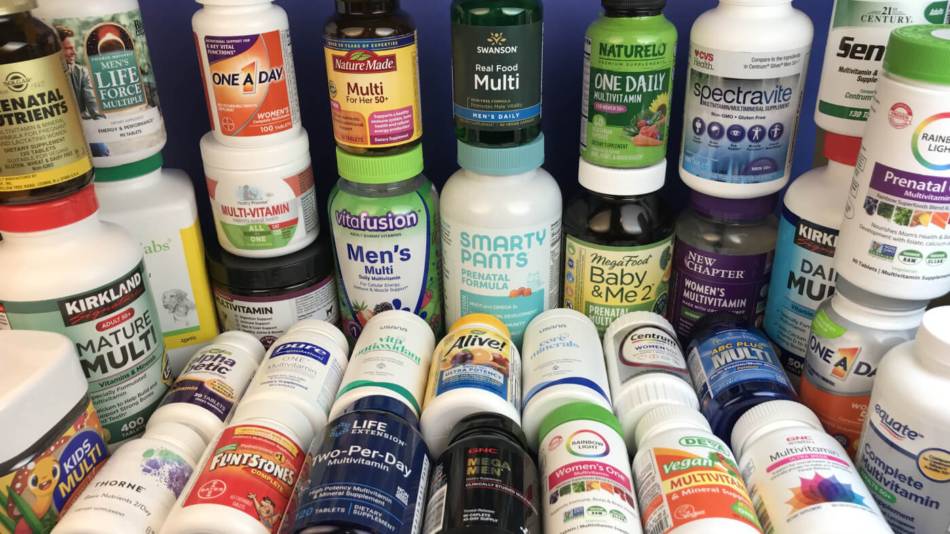Not all supplements are created equal. While some use natural ingredients, others contain synthetic nutrients that may be poorly absorbed and even harmful. By understanding these red flags, you can make informed choices and know about vitamin brands to avoid.
Natural vs. Synthetic
- Natural vitamins and minerals: Come from whole foods like plants or herbs. They’re typically extracted, dehydrated, and put into capsules or pills.
- Synthetic nutrients: Made in labs using chemicals to mimic natural vitamins. They’re cheaper to produce but often less potent and potentially risky.
Why Are Synthetics a Concern?
- Lower absorption: Your body may not absorb them as well as natural vitamins.
- Potential health risks: Studies suggest some synthetic supplements may contain residues of pesticides, heavy metals, or other harmful substances.
8 Vitamin Brands to Avoid
1. Vitamin D3 without Vitamin K2:
- Why it’s a red flag: Vitamin D3 helps your body absorb calcium and strengthens bones and your immune system. However, vitamin D3 also increases blood calcium levels. Vitamin K2 helps direct that calcium into your bones and teeth, preventing it from building up in your arteries, which can lead to heart problems.Therefore, when exploring vitamin brands to avoid, prioritize ones that don’t offer a balanced D3 and K2 combination.
- What to look for: Look for a supplement that contains both vitamin D3 and vitamin K2. The recommended daily value (DV) for vitamin D3 is 600 IU (international units) and for vitamin K2 is 120 mcg (micrograms).
2. Synthetic Vitamins:
- Why it’s a red flag: Synthetic vitamins are manufactured in labs to mimic the structure of natural vitamins found in food. However, they often lack the cofactors and co-nutrients present in natural sources, which are essential for optimal absorption and utilization by your body. Additionally, some synthetic vitamins may contain harmful residues from the manufacturing process.
- What to look for: Choose supplements that contain natural vitamins derived from whole foods like fruits, vegetables, and herbs. Look for terms like “food-based” or “whole food source” on the label. Avoid ingredients like:
- Retinol palmitate (vitamin A): Potential link to birth defects in high doses.
- Vitamin D2 (ergocalciferol): Less potent than vitamin D3 (cholecalciferol).
- dl-alpha-tocopherol (vitamin E): Less bioavailable form than d-alpha-tocopherol.
- Vitamin K3 (menadione): Can interfere with blood clotting medication.
- Pyridoxine hydrochloride (vitamin B6): Less absorbable than pyridoxal-5-phosphate (P-5-P).
- Cyanocobalamin (vitamin B12): Less bioavailable than methylcobalamin.
- Ascorbic acid (vitamin C): Can irritate the stomach in high doses.
3. Gummy Vitamins:
- Why it’s a red flag: There are several reasons why gummy vitamins are considered one of the vitamin brands to avoid. First, they are often loaded with sugar to make them appealing to children. This can contribute to weight gain and dental cavities. Additionally, they typically contain synthetic vitamins that are poorly absorbed by the body. Inaccurate labeling or inconsistent dosing are also concerns with gummy vitamins.
- What to look for: If you must use gummy vitamins, choose sugar-free varieties with natural flavors and colors. However, it’s generally better to opt for high-quality chewable tablets or capsules for adults and whole-food sources of vitamins for children whenever possible.
4. Megadose Supplements:
- Why it’s a red flag: Megadose supplements contain extremely high doses of nutrients, often exceeding 1000% of the DV. Synthetic vitamins, especially in high doses, may not be well absorbed and can lead to a buildup of certain nutrients in the body, causing toxicity.
- What to look for: Choose supplements with dosages closer to the Daily Value (DV) or Recommended Dietary Allowance (RDA). Consult your doctor to determine the appropriate dosage for your individual needs.
5. Unpurified Omega-3 Fish Oils:
- Why it’s a red flag: Omega-3 fatty acids, particularly EPA and DHA, are essential for heart and brain health. However, large fish can accumulate mercury, lead, and other toxins in their bodies, which can contaminate fish oil supplements.
- What to look for: Choose high-quality fish oil supplements from smaller fish species known to have lower levels of contaminants. Look for brands that undergo third-party testing for purity and potency. Certifications like USP (United States Pharmacopeia) or NSF (National Sanitation Foundation) can indicate a higher quality product.
6. Mineral Complexes with Inorganic Chelators:
- Why it’s a red flag: Minerals need to be bound to a carrier molecule (chelator) for proper absorption in the body. Inorganic chelators, like oxides, hydroxides, and phosphates, are often used in cheap mineral supplements. These chelators are poorly absorbed and can cause digestive issues like constipation or diarrhea.
- What to look for: Choose supplements with minerals bound to organic chelators like amino acids (glycine, lysine, etc.) or citrates (magnesium citrate, calcium citrate). These chelators are more bioavailable and less likely to cause digestive problems.
7. Products with Unnecessary Fillers:
- Why it’s a red flag: Supplement manufacturers may add fillers, preservatives, artificial flavors, and colors to their products to improve taste, texture, and shelf life. These ingredients can cause allergic reactions, digestive upset, or even contribute to chronic health problems in some people.
- What to look for: Choose supplements that are free of artificial ingredients and fillers. Look for labels that say “natural” or “non-GMO.”
8. Low-Potency Probiotics:
- Why it’s a red flag: While probiotics, live bacteria with gut health benefits, are a popular choice for supplements, there are factors to consider when choosing a brand. Look out for vitamin brands to avoid those that offer low-potency probiotics. These may not contain enough live bacteria to be effective. Additionally, the harsh acidity of your stomach can kill many probiotic bacteria before they even reach your intestines, where they can provide their benefits.
- What to look for: Choose a probiotic supplement with at least 60 billion CFUs (colony-forming units) per serving. Look for a product that includes multiple strains of probiotic bacteria and that is labeled “shelf-stable” or “refrigerated” to ensure the viability of the bacteria.
Stay tuned with Med Hacks for further information like this!

 +92 306 4790704
+92 306 4790704 info@medhacks.online
info@medhacks.online


Leave a Reply